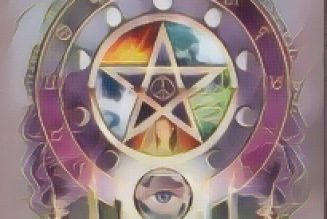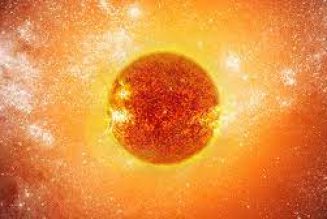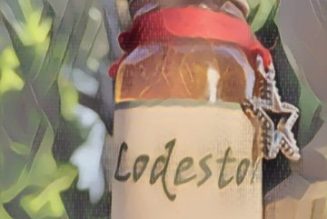Astrology, the study of the influence of the stars and planets upon life on this earth, is another of the fundamentals of magic. It is studied by witches and magicians alike. In the past, it was as important to the village witch in her lonely cottage, as it was to the wealthy and learned man who practiced magic behind the locked doors of his study.
The basic premise of astrology is contained in the famous sentence from the Emerald Tablet of Hermes Trismegistus: ” Quod est inferius
est sicut quod est superius, et quod est superius est sicut quod est inferius, ad perpetranda miracula rei unius.” (“That which is below is like unto that which is above, and that which is above is like unto that which is below, for the performing of the miracles of the One Thing.”)
In other words, the universe is unity. Vibrations thrill throughout it, manifesting upon different planes as different effects, material or
non-material. These vibrations basically correspond to the sacred number, seven; hence they are sometimes called the Seven Rays.
In our solar system, the planets and luminaries have been named after the gods who rule these Seven Rays, who are known to us as Saturn, Jupiter, Mars, Sol, Venus, Mercury and Luna. The actual planets and luminaries visible to us in the sky are the physical manifestations of these influences and the means whereby they are transmitted to the earth.
Beyond Saturn, the farthest planet visible to the naked eye, are Uranus, Neptune, and Pluto. These are regarded generally by astrologers as
higher and more spiritual versions of the planetary influences of Mercury, Venus and Mars, rather like a musical note being repeated an
octave higher. Paracelsus, the great occultist of the Middle Ages, predicted the discovery of other planets, telling his contemporaries that
“there were some stars that had not yet cast their rays”.
It has been objected to astrology that it is founded upon the ancient ideas of astronomy, which pictured the earth as the center of the universe, and the sun and all the planets and stars as revolving around it. Today, the critics say, these notions are all exploded, so astrology must perish with them. However, astrology always has been based upon the apparent motions of the heavens, as seen by us on earth. For us as human beings, for our practical purposes, the earth under our feet is the center of the universe and the sun does rise in the east and set in the west. Astrology, witchcraft, and magic are often most misunderstood precisely when they are most down-to-earth and practical.
A horoscope is a chart of the heavens as they appear to a person on earth at a particular place and a particular time. The so-called ‘horoscopes’ which often appear in the popular press are not really horoscopes at all; they are brief, generalized readings from the current positions of the planets as they affect the twelve different signs of the zodiac.
There. are really two zodiacs, the zodiac of the constellations which can be seen in the night sky, and the zodiac which is the plane of the
ecliptic. The former is called the Sidereal Zodiac, and the latter the Tropical Zodiac. The astrologers of India and the East generally, still use the Sidereal Zodiac; but those of the West mostly use the Tropical Zodiac.
The latter is the apparent path of the sun in a year, as it appears to circle the earth. Like any other circle, this has 360 degrees. These are
divided into twelve signs of 30 degrees each, and these twelve signs are named after the shining constellations of the Sidereal Zodiac. The Tropical Zodiac commences at the spring equinox when the sun appears to enter the sign of Aries, the Ram, and day and night are equal. But owing to the phenomenon called the precession of the equinoxes, this point no longer coincides with the constellation Aries. It is the constellation Pisces, and slowly moving back towards Aquarius. It does in fact pass very slowly backward through all the constellations, in a cyclic movement which is called the Great Year of Twelve Ages, a span of time lasting over 25,00 earthly years.
These Twelve Ages actually reflect the characteristics of each zodiacal sign, and this can be traced in world history, as Vera W. Reid has shown in her book Towards Aquarius (Riders, London, 1 944). We are now in the transition period between the Age of Pisces and the Age of Aquarius; hence the world unrest and breakdown of the old forms of society, and of old-established ideas, manners, and moral codes, which so alarms many of the older generations. But together with this breaking-down process, a building-up is also going on, of the ideas and ideals characteristic of the Aquarian Age which is coming; an age which, occultists believe, will be a happier and more enlightened one than the Age of Pisces, which is now crumbling to decay.
On 5th February 1962, an unusual astrological event occurred. All seven of the oldest-known planets, Mars, Saturn, Sol, Luna, Mercury,
Venus and Jupiter, in that order, were gathered in the Sign of Aquarius. Astrologers regarded this as of great significance; some said that it might indicate the birth of some great soul, who would further the ideals of the Age of Aquarius, which is the sign of the brotherhood of man.
We can only hope that they might be right.
The twelve signs of the zodiac are ruled by the planets and luminaries, called for convenience the seven planets. (The ancients were perfectly
well aware that the sun and the moon are not planets, but it was needlessly awkward to keep making this distinction.) These sacred seven
extend their rulership over everything upon the earth; the day of the week, the colors of the rainbow, minerals, metals, jewels, plants, trees,
animals, fishes, birds; everything in Nature has its astrological correspondence and rulership.
The great importance of these rulerships in practical magic can easily be seen. If, for instance, a witch wants to select a herb to use for a
magical purpose, she has to use one whose astrological rulership is correct for the work in hand. Love charms, for instance, will call for
herbs ruled by Venus. The moon rules psychic things, and a herb of the moon, mugwort, or Artemisia vulgaris, is used to make an infusion
or tea which many believe is an aid to clairvoyance. One of the tasks of the would-be magician is learning astrological correspondences, and the signs and symbols relating to them, from such books as Aleister Crowley’s 777 (777 Revised: A Reprint with Much Additional Matter, The Neptune Press, London 1 956), or The Magus, by Francis Barrett (London, 1 801), (This latter book was a favorite of ‘Cunning’ Murrell, the famous wizard of Hadleigh, in Essex.)
All the older herbals, such as the original seventeenth-century Culpeper’s Herbal (Culpeper’s English Physician and Complete Herbal,
Nicholas Culpeper, first published London, 1 652, and Wehmann, 1 960), contain the astrological rulerships of the herbs they recommend. Old Nicholas Culpeper himself gives many dissertations about the importance of astrology in treating diseases, saying that physic without
astrology is like a lamp without oil. His Herbal, together with William Lilly’s Introduction to Astrology (London, 1 647), were part of the stock-in-trade of many of the later village witches.
Lilly gives many examples of horary astrology; that is, answering questions, discovering stolen goods, etc, by means of an astrological
figure set up for the time of the question or the event inquired about. This was and still is an important branch of magical practice, though
often brought into disrepute by charlatans.
At the present day, a witch is known to me, who is the leader of a coven, makes practical use of astrology in selecting suitable members. If
anyone wants to join her coven, she asks them for their time, place, and date of birth, and casts their horoscope. From this, she deduces whether or not they will make good witches, and if they will be able to work in harmony with other members of the coven.








